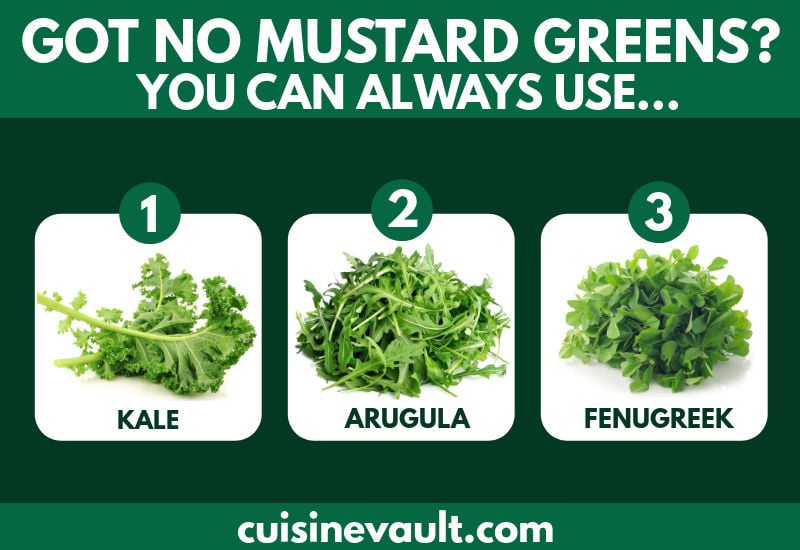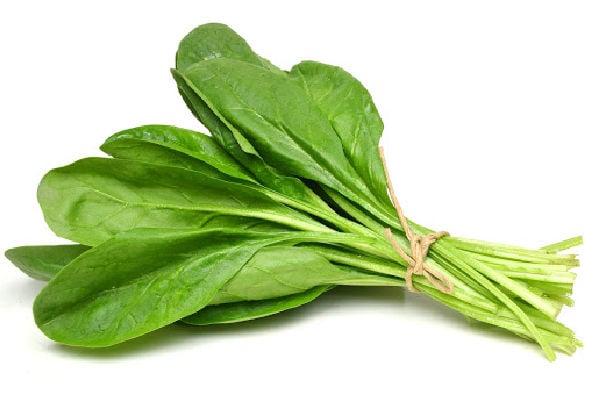Mustard greens are a yellowish-green leafy vegetable that have a pungent, peppery flavor and a fibrous texture. When eaten raw the leaves have powerful mustard and wasabi-like notes, but cooking will reduce the intensity.
Although mustard greens are a useful ingredient in the kitchen, they’re difficult to find in many grocery stores, especially when they’re out of season. If you can’t find any then keep reading, we’ve pulled together our favorite substitutes for mustard greens which will taste just as good as the original ingredient.
How do I replace mustard greens in cooking?
The best substitutes for mustard greens are kale, arugula, or fenugreek leaves. For a milder option, try spinach leaves or escarole, which are likely to appeal to a wider audience. Chinese broccoli and rapini are good stand-in options for those that enjoy food with a bitter intensity; they aren’t suitable for raw dishes like salads.
 1. Kale
1. Kale
Kale is a member of the cabbage family and comes in smooth or curly varieties. The most common is the latter of the two. Whichever option you choose, you'll find that kale is bitter and peppery with a texture that is a very close match to mustard greens.
Kale won’t provide the same mustard and horseradish bite but it is versatile – perfect for tossing into salads or for cooking.
If you can find it (or grow it), lacinato kale is a slightly sweeter variety with an earthy, bitter flavor. Its dark blue-green leaves make a useful substitute for those who want less “bite” in their food.
2. Arugula
Arugula, or rocket, is a type of salad green with a subtle bitter and peppery taste. This is a great option in salads, but its texture is more delicate and won't hold up to cooking as well as mustard greens. If you must cook arugula, toss it in at the end as it only requires a short cook time.
3. Fenugreek leaves
Fenugreek is an annual herb that has a subtle nutty and sweet flavor that some describe as a cross between maple and celery. The seeds are often used as a spice, but the leaves make a great mustard green substitute in cooking.
Although this ingredient is commonly used in Indian food, it can easily fit into recipes from other parts of the world. Your biggest challenge with this option is that it can be tricky to find unless you have an Indian grocer nearby.
4. Spinach leaves
Spinach is a common vegetable that's easy to find in store. The green leaves are mild and slightly sweet, ideal for salads. Once cooked, they become more acidic.
 Spinach leaves are much milder than mustard greens and lack the peppery, mustardy flavor. They also turn limp quickly when cooked and tend to release more liquid. However, these leaves are the perfect solution if you're feeding kids or people that don't enjoy strong-flavored foods.
Spinach leaves are much milder than mustard greens and lack the peppery, mustardy flavor. They also turn limp quickly when cooked and tend to release more liquid. However, these leaves are the perfect solution if you're feeding kids or people that don't enjoy strong-flavored foods.
If you're making a salad or any recipe that doesn't involve cooking, we suggest using young baby leaves. The mature ones aren’t as tender and have a more intense bitter flavor.
Tip: Add a liberal sprinkle of pepper to get closer to the flavor profile of mustard greens.
Related reading: What does Malabar spinach taste like?
5. Escarole
Escarole is another leafy green that has a vegetal taste with a subtle bitter undertone. The light-colored leaves on the inside of the plant are sweeter than the darker outer leaves. Like spinach, this is a better replacement for those searching for a less pungent ingredient.
Use escarole in salads or boil, steam, or sauté it like you would other leafy greens. They are also an excellent addition to soups, stews, and other slow-cooked dishes.
6. Swiss Chard
Chard is related to the beet and has thick, fleshy leaves and crunchy stems. The dark green leaves taste a cross between spinach and beets with an earthy flavor that has a slight bitterness.
These leaves are best cooked as they are bitter and a little tough. Allow extra time for cooking Swiss chard leaves if you use them as a substitute for mustard greens.
Tip: The stems and leaves are both edible, but we recommend cooking them separately to avoid overdoing the leaves.
7. Collard Greens
Collard greens are a bitter vegetable but are a milder version of mustard greens. Use them as a replacement in sandwiches and salads or sauté them briefly in olive oil for a nutritious side dish.
Choose this vegetable if you want a backup option with a similar texture to mustard greens but with a more muted mustard flavor.
8. Chinese Broccoli
Chinese broccoli is a leaf vegetable with thick glossy green leaves, florets like broccoli, and thick stems. They are a popular option in Thai, Vietnamese, and Chinese cuisine, offering an earthy, mildly bitter taste.
This vegetable is excellent for stir-fries and sautéing as it holds up to heat well. Its thick, tough stems make it a poor replacement in dishes where the mustard greens are eaten raw.
9. Rapini
Rapini, or broccoli raab, is a member of the turnip family and is popular in Chinese and Italian cuisines. Depending on when its harvested, rapini can range from bitter through to intensely bitter. It is another option that stands up well to the heat; we wouldn't recommend using this option raw.
 Hint: Blanch the florets before cooking with olive oil to help tame the bitterness.
Hint: Blanch the florets before cooking with olive oil to help tame the bitterness.
10. Dandelion Greens
Dandelion greens have a mild peppery flavor and if they are harvested young enough, they are perfect for salads. As they mature the leaves become tougher and are more suitable for cooking. This ingredient will be difficult to find in most supermarkets so it may be better to plant some in the garden for next time.
Check out our article of edible flowers to get more delicious floral ingredients to add color and flavor to your next dish.
11. Turnip Greens
Turnip greens are the tops of the turnip root, which is part of the brassica family. Their flavor is a close match to mustard greens, although bitterer. You can use these instead of mustard greens but choose young, tender stems to use in raw applications.
Kohlrabi tops will also work in similar applications to turnip greens.
12. Chinese Mustard Greens
Gai Choy is a type of mustard green that often can be found at Asian grocers. It is a less delicate version of the regular mustard green and is popular in Asian cuisine. Use this ingredient to make pickled mustard or add the fresh leaves to stir-fries.
Related reading:
What are the best substitutes for purslane?
Fast facts about mustard greens
- The vegetable is part of the brassica family and its botanical name is Brassica juncea.
- It is popular in African, Italian, and Asian cuisine.
- Mustard greens can be eaten raw or cooked, and the younger leaves are noticeably more tender with less bite.
- Flavors like chili pepper, vinegar, and garlic all pair well with mustard greens.
Summing up
Mustard greens are a healthy vegetable that add flavor to food. For some, the flavor is too intense, while others simply won't be able to find it at their local store. Whatever the reason, if you need to replace mustard greens in a recipe use kale, arugula, or fenugreek leaves for a similar flavor and texture.
What recipe are you looking to make that calls for mustard greens? Please let us know in the comments below.

Leave a Reply